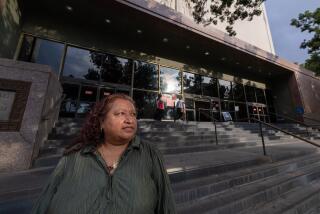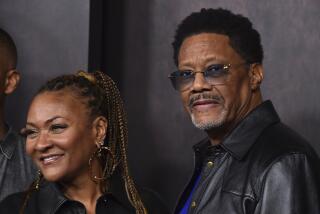Do-it-yourself divorce doesn’t always sever ties
When Yanic Chan and Vanessa Van split up in 1995, they couldn’t afford a lawyer. So, like thousands of other people without money, they filled out the divorce paperwork themselves, with help from a friend.
In November 1997, Van went to the Riverside County Courthouse to enter a final judgment. “The clerk put the stamp on it,” Van said. “I asked, ‘Everything finished?’ She said ‘Yes.’ ”
Chan returned to his native Cambodia and married again. Then, in 2006, he tried to bring his new wife to this country. And that’s when Van and Chan got a nasty surprise, one that court officials fear could be awaiting thousands of other former California couples: Their divorce had not been finalized.
Driven by rising legal fees, a shortage of legal aid lawyers and a do-it-yourself philosophy, about 80% of people in California handle their own divorces, according to court officials.
Many of them are not quite as divorced as they think they are. Some of them, like Chan, are even accidental bigamists, carrying not only hopes and dreams but also an earlier marriage to their new one.
Tens of thousands of others have some understanding that their divorces are not done. But stumped by complex paperwork and court procedures, and unable to afford thousands of dollars for attorneys, they simply let their cases languish.
Court officials across the state say they suspect the problem is vast. In Los Angeles County, Kathleen Dixon, who heads the Superior Court’s programs for self-represented people, estimated that a third or more of all divorce petitions filed in the county in the last several years have not been finalized.
Neither state nor county officials have statistics because they don’t monitor cases to make sure they are finished. But the evidence they have worries them.
One L.A. County Superior Court judge, Mark Juhas, found that about a third of the roughly 3,600 divorce cases filed in 2001 and 2002 and assigned to his courtroom remain open. Some of those couples may have reconciled, but Juhas suspects that many more are stuck or may even think they are divorced when they are not.
Bonnie Hough is supervising attorney for the Center for Families, Children and the Courts, a division of the state Judicial Council’s Administrative Office of the Courts. She noted a study in Placer County in the 1980s that found that 30% of people there who filed for divorce did not complete the process.
At one legal services center in Van Nuys, officials say they see 20 people a month who incorrectly thought they were divorced.
“They come in screaming,” said Norma Valencia, a paralegal at the center operated by Neighborhood Legal Services. “They say, ‘You don’t understand my situation. I want a divorce right now.’ ”
Others show up weeping: They’ve remarried without a finalized divorce, and they’re afraid to tell their new spouses.
Many people, Valencia said, think divorce is like a traffic ticket and if they fail to take care of it properly, the court will track them down and notify them.
But it doesn’t work like that. In California, getting divorced takes at least three steps: filing divorce papers, serving them on the spouse and then writing and processing a judgment with the court. The process can be more complicated if there are children or fights over assets. A divorce cannot become final until at least six months after the date the papers are served.
Increasingly, across California and the nation, people are handling their own civil court matters. In San Diego County, one of the few counties where statistics are available, 46% of people represented themselves in divorces in 1992; by 2000 that figure had climbed to 77%.
One reason: increasing fees for lawyers combined with decreasing legal aid services for poor people, said Richard Zorza, who coordinates a national network of organizations working on self-representation.
Also a factor, he said, is a “Home Depot philosophy of people feeling they can do things on their own.” But the legal system wasn’t organized with a do-it-yourself approach. It’s meant to be navigated by lawyers. And people without legal training often make mistakes.
“People just don’t get it done. They don’t know how to get it done,” said Juhas, the Los Angeles Superior Court judge. “That’s troubling. There are legal ramifications to continuing to be married.”
Juhas said the problem was brought home to him a few years ago, when two people appeared in his courtroom on a routine matter. They had filed for a divorce a few years earlier, and both had since remarried. Juhas said he looked down at their file and then back up at the couple. “I said, ‘Do you realize your judgment was never entered?’ ”
In plain English, that meant they weren’t divorced. Luckily for the couple -- and their new spouses -- Juhas finalized their divorce without invalidating their new marriages.
But it got him thinking: What about the thousands of other people whose files remain open?
Last spring, the judge, one of more than 40 who handle family law in L.A. County, began calling in about 100 people a month whose divorce cases have languished and asking them if they need help.
About 10% say they have reconciled, and about 30% ignore his summons. But more than half, he said, want to be divorced and just need some help.
Just after 9 a.m. on a recent morning, Juhas hoisted a stack of divorce files onto his desk and began calling names. About a dozen people stared back. Some were alone. Some were with spouses. Some looked fearful. Others glowered. Juhas asked them to stand and follow Janice Shurlow, a lawyer who works with the court helping people representing themselves.
Shurlow led them to a conference room. “If both parties are here and you get along, please feel free to sit together,” she said. “If you don’t get along, feel free to sit on opposite sides of the room.”
For the next two hours, attorneys, some volunteer, others employees of the court’s family law resource center, assisted people with paperwork.
A man with tattoos lacing up his neck and down his arms bent over a stack of forms in the front of the room. The man, who said he did not want his name printed because of the personal nature of the matter, said he had filed for divorce in 2002.
“I thought I was divorced,” he said. A moment later, he said he knew he wasn’t divorced but was uncertain about what to do after his spouse refused to sign papers he gave her.
“Out of sight, out of mind,” he said. He looked at the mass of paperwork in front of him and sighed. “It’s so easy to get married. Sign your name and say, ‘I do,’ ” he said. “Say I don’t. I don’t want to be married anymore.”
Court officials say they are studying Juhas’ approach and may expand it if it proves successful.
At the same time, court officials in L.A. and elsewhere in the state have launched self-help programs so people can get divorced.
But that does little to help the thousands who are stuck in legal limbo now, Chan and Van among them.
After they thought their divorce had become final in 1997, Chan married a second time. He divorced -- properly -- in 2003, although he later discovered that marriage was not legally valid.
But that was nothing compared with the problem he encountered when he tried to bring his third wife to the U.S.
Earlier this year, he got a notice from the U.S. State Department asking for proof of his divorce from Van. He provided the paperwork the Riverside court had given him in 1997.
“They said everything is not final,” Chan said. “I felt very upset. I could not eat for three days.”
He found a lawyer, Faith Nouri. She said a judge had asked for additional information about child visitation. But Van and Chan say they had never received any notice from the court.
In 2001, after their case had been dormant for five years, the Riverside court dismissed it. Again, Chan and Van said they were never notified.
But now there is no easy way for a judge to retroactively divorce them.
Nouri said she plans to ask a judge later this month to set aside the dismissal, but she said “it’s a long shot.” If the judge won’t, Nouri said, she doesn’t know how Chan can bring his new wife to this country.
“Then he is in a bigamous marriage,” she said. “There will be a lot of explaining to do.”
More to Read
Sign up for Essential California
The most important California stories and recommendations in your inbox every morning.
You may occasionally receive promotional content from the Los Angeles Times.










